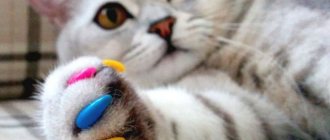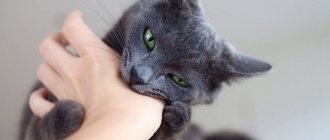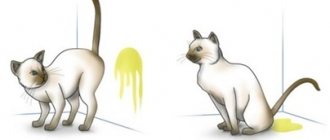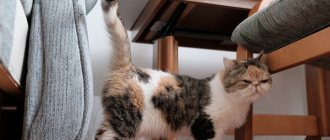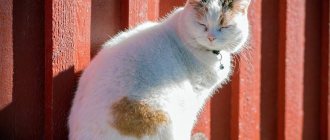Obeying instinct, cats bury their feces in the ground. Perhaps this happened in your case too. If the suspicions are confirmed, you will have to try to wean your pet from this activity.
Why do cats dig in flowers?
There are several reasons why domestic cats climb on pots of soil and chew green spaces in the house. Here's what experts think about this:
- Lack of vitamins and microelements in the animal’s body. Street cats look for medicinal grass and eat it, which allows the body to obtain the necessary substances. Domestic cats can eat plants in flower pots, which is very unsafe for the animal itself. For example, some types of house plants are poisonous, and if a cat begins to gnaw on such a stem, there is a high risk of severe poisoning of the animal.
- The cat is looking for a convenient place to go to the toilet. For example, the animal does not like the filler in the tray, but the soil in flower pots is very convenient for this matter. The reason for this cat behavior can also be an uncleaned litter box. Keep the cat litter clean and change the litter in it in a timely manner.
- Cats can climb on window sills and damage green spaces solely because of resentment toward their owner due to lack of attention. With this behavior, the cat not only wants to take revenge, but also to draw attention to itself.
It is not difficult to understand the main reason why a cat climbs into flower pots. If an animal digs the ground and relieves itself there, it means that she is unhappy with her cat litter. The cat eats the stems and leaves of plants - its body lacks vitamins. An animal simply spoils flowers in pots, throws them on the floor, chews leaves or breaks branches - a clear sign of a lack of attention on your part.
Reasons for this behavior
So, if your cat eats indoor flowers and climbs into pots precisely for this, then often the opinion that the animal lacks some vitamins and nutrients is a misconception. The fact is that in nature, cats eat meat with bones, veins, skin, and at home, most often soft and light food. Therefore, the stomach gets clogged, plus the fur, and the pet tries to cure itself by eating plant foods.
In this case, you should not immediately try to stop climbing flowers, but diversify your diet and include so-called emergency methods. The first thing you can do is plant any indoor herb and give it to your cat to eat. These can be any cereal sprouts, for example, oats, barley, wheat. If your pet doesn’t eat them on their own, you can finely chop them and add them to the food.
Of course, you also need to pay special attention to the fur, comb the cat more often or give special products to cleanse the stomach of fur.
If the cat eats soil and therefore climbs into pots, then this is a sure sign of a lack of minerals. To do this, I advise you to contact a veterinarian, take the necessary tests and adjust your diet. Supplementing with any complex vitamin and mineral often helps. Only after this can you successfully wean your pet from the habit of eating soil.
If a cat climbs indoor flowers and simply digs the ground, then this is a kind of manifestation of instinct and some kind of fun for the pet. The fact is that in nature they bury their excrement in the ground. There is only one way out in this situation - to change the filler in the tray to a looser, quickly absorbing one that imitates soil.
Exploring the world around us
Both children and kittens actively explore their environment. The desire to taste inedible objects, including plants and soil, can lead to negative consequences for your pet. Toxic finishing materials and poisonous flowers often lead to poisoning and death of the animal.
If you notice your cat's increased attention to dangerous objects, you should interest her in new toys or plants specially grown for chewing. You can germinate wheat, oats, and lawn grass in a pot. Edible toys will keep the kitten occupied for a long time and dangerous sabotage will not become a habit.
An animal can also start using a pot with soil as a toilet. Scattered soil and a damaged plant will bring little joy to any owner. Therefore, if you cannot distract your pet from a container with soil, then it is better to move the flowerpot to an inaccessible place.
Method 3: Fragrances
The problem of eating plants can be solved by using aromatic substances. Cats are sensitive to odors. With their help, they navigate in space and identify food.
There are three groups of scents that are unpleasant to representatives of the cat breed:
- Citrus aromas - place lemon, orange or tangerine peels around flower pots, sprinkle greens with a decoction based on citrus pulp and peels.
- Essential oils – add 10 drops of lavender or eucalyptus oil to a glass of water and spray the solution onto problem areas.
- Herbs and spices - mix mustard, garlic or curry with water, use the prepared solution to moisten the foliage and trunks of plants, the soil in the pots.
Please note that aromatic substances disappear quickly, so spray the plants several times a day. To enhance the odorous properties, use a Levomycetin tablet, dissolve it in a glass of water. The resulting bitterness will be enough to discourage your pet.
Use ready-made veterinary drugs. Buy special repellents at the veterinary store that have an unpleasant smell and taste, and place them around the pots.
IMPORTANT! When using repellent sprays, apply them only to pots and soil. Make sure that the substance does not get on the plant. Repellents are very dangerous for stems.
Leave a request for a cat hotel
Methods to combat the problem
The first thing to do in this situation is to raise the cat and, whenever you try to get close to the flower pots, say loudly “No!”
Observing your pet will give you an answer as to why he does this.
Observe, maybe the cat climbs onto the windowsill not in order to spoil your green spaces in the house, but in order to get closer to the window and inspect everything that is happening on the street. In such a situation, the problem can be solved easily and simply! Remove a couple of peas from the windowsill to create an observation deck for your inquisitive kitty.
If your cat digs the ground and shits in it, try changing the type of litter for the litter box. Did not help? Then use a special spray to repel animals. You can buy it at a pet store.
Traditional methods also work effectively:
- Place citrus peels near the plants, pets cannot tolerate this smell;
- cats also don’t like the smell of garlic, place garlic cloves next to flower pots;
- Cover the window sill with food foil, animals do not like to walk on a rustling surface;
- you can use a spray bottle of water to scare away the cat; water treatments will quickly eliminate interest in walking on window sills;
- flower pots can be lubricated on the outside with “Star” balm or essential oils with strong odors;
- Some are helped by ordinary toothpicks, tightly inserted into the ground with flowers with the sharp side like a “hedgehog”; a couple of unpleasant touches will reduce the cat’s interest in home flowers;
- cover the soil in the pots with small pebbles, they will not harm the plants, but will eliminate the cat’s interest in the filler of the flower pots;
- You can put double-sided tape next to the pots; cats don’t particularly like to walk on sticky surfaces.
If your furry friend eats plant leaves and stems, try planting a pet-specific grass in a pot. You can buy such seedlings at a pet store. Green grass is rich in various vitamins and microelements, which will bring undeniable benefits to the body of your tailed pet.
Out of range
You can move flower pots out of reach. Of course, cats will climb anywhere, but the method may work.
Pots on window sills need to be hung or raised on special stands. They are sold in flower and hardware stores. Greenery on cabinets is easier to save: remove everything underneath that can be climbed up.
Close the plantings in one room and keep the animal out. Due to his natural curiosity, he will use cunning to try to penetrate inaccessible territory. But if everyone in the household closes the door, the cat will be left with nothing.
Mental disorders
Pica is a disorder similar in severity to anorexia and bulimia. Expressed in the desire to eat inedible objects. Appears as a result of mental disorder, nervous shock and can lead to death.
Research by scientists on animal behavior has revealed that pets, just like people, are susceptible to depression and fear. Pica in science is divided into two types:
- A common disorder is eating paper, stones, and earth.
- Coprophagia is the eating of feces.
Cats are susceptible to both forms of the disease. In order to determine why a cat eats soil from a psychological point of view, it is necessary to analyze all the facts from the pet’s life.
The problem could begin in childhood, especially for animals picked up from the street at an early age. Starvation leads to death after 3-4 days. Even if the kitten was rescued during this period and provided with the required care, the consequences of the injury may appear several years later. The animal will more often suffer from gluttony throughout its life, and this often leads to the second type of eating disorder - coprophagia.
It is more difficult for a domestic cat to experience hunger, which, due to circumstances, finds itself on the street and is forced to remain without food. Having found a secluded refuge, the pet hides and the feeling of fear blocks the need for food. The pet is paralyzed by fear and prevents it from moving. If the owners manage to find the animal and save it, then recent impressions haunt the shocked person for a long time. Here is another psychological reason why a cat eats soil from indoor pots.
Consequences of eating houseplants
As we have already said, many plants in the house are poisonous species, and after consuming them, the animal may be in real danger. What may be the consequences of consuming poisonous plants:
- prolonged diarrhea in a cat;
- nausea, vomiting, loss of appetite;
- severe dehydration of the body;
- general weakness, coma;
- death.
If you do not want to lose your furry friend, protect him from the following plants in the house: dieffenbachia, caladium, azalea, philodendron, schefflera, chrysanthemum, ivy, cyclamen, etc. If your cat has managed to eat the leaves or stems of poisonous plants, immediately take her to an experienced veterinarian.
Cats look for healing herbs and eat it, help them find it
To bring your animal to the doctor, provide him with first aid to neutralize the effects of dangerous poisons:
- do a cleansing enema with warm water;
- Give your cat a mixture of vegetable oil, egg whites and milk.
Never leave your cat alone with dangerous plants in the house. Better yet, get rid of such plantings if a furry pet has settled in your home.
Be sure to raise your cat from the first days of being in your family. Love, but do not pamper, mark the boundaries of what is permitted. If the animal behaves badly, scold it, but for good behavior you can reward it with your favorite treat.
You need to raise an animal correctly, without involving physical violence in this matter. Only instructive conversations in a strict intonation will allow you to raise an obedient cat with good manners and decent behavior.
Well, many owners are simply lucky with indoor cats who do not show any particular interest in indoor plants. If your pet is more inquisitive and has already managed to get into trouble on the windowsill, use the above methods to deal with the bad behavior of your four-legged friend.
Reviews
Dear readers, was this article helpful? Have you ever encountered a situation where you had to stop your cat from chewing flowers? Leave feedback in the comments! Your opinion is important to us, and it will be useful to other people who also have their pets chewing flowers!
Veniamin, Krasnodar
“Our cat often raided pots of geraniums, and my wife and I treated this as a necessary evil. Once, my wife sprayed flowers against pests with water infused with dry lemon peels. The cat came up, sniffed and darted out of the room. I didn’t approach them for a long time. Then the effect of the infusion apparently weakened, and he began to act evil again. But we were already on our guard. There was no need for a third time: the cat doesn’t come near the flowers anymore.”
Diana, Alushta
“I taught my Marfusha not to bite flowers using double-sided tape. We live in a microscopic one-room apartment, one window - onto the balcony, but my soul wants flowers! Anyone who has fifty violets will probably not even notice that there is one less. And I only have three of them! And the cat began to eat these unfortunate violets little by little. Once I found a leaf on the floor, twice... I decided that it had fallen off on its own. Then the cat realized that she could do anything, and climbed onto the windowsill right in front of my eyes. “Like you, so am I!” – I thought and immediately demonstratively covered the entire window sill with double-sided tape. The cat carefully watched my actions, not understanding what awaited her. When I went to wash my hands, I heard her wild howl. She stomped on the windowsill, unable to unhook herself, and screamed in horror. One time was enough for her not to even come close to the window.”
The dangers of the home garden
Indoor flowers can pose a major threat to a cat's health. The poison contained in plant sap can cause serious damage to your pet:
- cause stomach upset and cramps;
- create intestinal obstruction;
- provoke allergies;
- burn the mucous membrane;
- lead to disruption of organ function.
Cats should not eat flowers such as:
- Kalanchoe;
- violets;
- lilies;
- orchids;
- hydrangeas;
- azaleas;
- spathiphyllum;
- begonias;
- chrysanthemums;
- lilies of the valley;
- daffodils and other types of plants.
We suggest you read: Is it possible to give rice to a cat?
Why do they do this
Animals of any gender and age can shit in the wrong place. Experts say that most often an unpleasant situation arises not because of the cat’s poor upbringing or character, but because of health problems or as a way of realizing instincts and natural needs. Pets go out of place because:
- They are not satisfied with the location of the tray in the apartment. You need a fairly secluded place away from prying eyes. If something constantly distracts and bothers your cat while visiting the toilet, he can choose another corner or the owner’s sofa for this.
- The tray is too small or has a strong smell of detergent. The cat is uncomfortable in such a toilet and, not wanting to experience discomfort, she looks for another place.
- It is possible that the animal does not like the look of the filler. The range of these products is now wide, try changing the filler to some other one, this may solve the problem.
- Tray not removed on time. Cats are big cleaners and if their litter box is filled with excrement, they may refuse to use it. If you are away from home for a long time, it is better to put another tray so that the degree of contamination of the cat litter is not excessive.
- The cat has changed its place of residence or has experienced stress. In the first case, the animal may simply not yet get used to the new place, and in the second, it expresses its feelings in this way.
- Infection with worms, intestinal and genitourinary diseases can cause pain in a cat when defecating. In this case, the pet will associate the litter box with causing pain and he will avoid going to the toilet. In this case, only a visit to the veterinarian and further therapy will help.
- After all, cats may simply be marking their territory. They will visit the litter box, but at the same time they leave marks and odorous puddles throughout the apartment. The situation will be corrected by castration or free walking, during which the pet will find a sexual partner.
Reasons for cat disobedience
Why did the cat suddenly start doing its business on the bed or peeing everywhere? Perhaps this is a bad omen and we should sound the alarm?
If a cat is disobedient, you need to find out the reason for its behavior.
The cat does not like the tray, the location of the toilet, the filler
This is one of the most common reasons that a cat has stopped going to the litter box - the animal simply does not like the toilet or the smell of the litter. This happens if, for example, you purchased a new tray or washed the old one with new cleaning products. Cats prefer to go pee where there is already some smell of their urine. Therefore, if you try too hard to rid the cat’s litter box of the smell, then he may start going to the toilet nearby, on the bed, or anywhere else. The ideal tray should be:
- twice as long as the cat itself or at least 1.5 times,
- do not have strong odors,
- it should not have been used for its intended purpose by other animals,
- It is better to take filler without a special smell.
In order for the cat to stop shitting next to the litter box and start using the litter, you need to do the following: replace the litter box itself, change the cleaning products and not be overzealous with them. It’s better not to wash a little, than to leave the acrid smell of detergent.
It is better to place the tray in a rather secluded place where there is not a lot of traffic. The cat's food should not be nearby, because the cat shits always far from the place of food. One option to make your cat feel comfortable and cozy when peeing is to purchase a covered litter box. This way she will feel protected and will gladly agree to visit her own toilet, and not shit everywhere.
Perhaps the reason is that the cat does not like his toilet
What should you do if your cat needs to be accustomed to a new litter, but the animal doesn’t like it? In order for the cat to get used to it and begin to go to the new substrate, add the new filler little by little to the old one. And gradually switch completely to the one you chose for your pet.
If, after eliminating these reasons, the question of why the cat does its business next to the tray is not resolved, perhaps this is due to other problems.
Associations
If your cat poops on the bed or nearby rug, it may be associating your bedspread or floor covering with the litter box. To avoid such mistakes by your pet, remove for a while those things that may be associated with the litter box, cover the bed with another blanket and observe. If your cat or kitten shits on the bed, this is a bad omen; perhaps he is offended by the owner and is simply taking revenge. If the cat began to go only to the litter box, everything worked out for you, and the reason was precisely in the associations.
Revenge
Yes, this is also one of the reasons that is inherent in this behavior of cats. If the cat is offended, the owner's bed or his things may be damaged. And so that your pet doesn’t start peeing anywhere, love and respect him, don’t beat him or scold him in vain. But what should you do if this has already happened, and the cat shits on the bed or starts doing it everywhere? Make every effort to make your pet feel your care, warmth and care and begin to go and pee on the tray as before.
Disease
Urolithiasis, worms, prolonged constipation - all this can lead to problems with discharge and cause pain to your pet. Therefore, the cat may associate the cat litter box with discomfort, and he will begin to avoid peeing in the right place.
And if suddenly the cat, for no particular reason, begins to go to a place other than the litter box to relieve itself, pay attention to its health. This could be a bad omen
What to do? Contact a specialist and get treatment.
Sometimes a cat's refusal to use the litter box can signal health problems.
Stress
Just like people, our smaller brothers can experience stressful situations that entail consequences. Moving, the arrival of a large number of strangers into the cat’s territory, the appearance of a child or a new pet in the family - all this can cause the cat to stop going to the toilet.
Love and caress your pets, and they will definitely reciprocate your feelings and will not become the cause of your troubles.
Lack of essential enzymes
- Take a closer look at the behavior of the animal, unless this feature worsens with the onset of spring, then you can say that the cat, most likely, don’t drink - I don’t want useful compounds. Simply put, the animal suffers from vitamin deficiency.
- This will especially indicate that the cat is happy to eat store-bought regolith. This composition contains many valuable compounds. Bavaria is enriched with fertilizers. As a result, the cat tries to replenish the elixir of life it needs.
- Most often, animals suffer from a deficiency of phosphorus, calcium, sodium and potassium. In this case, it’s a good idea to carefully create a diet so that the cat stops eating soil. Besides this, some cat owners claim, what is it? An animal may experience a deficiency of certain elements due to eating a large amount of meat.
- The problem is that such a product flushes calcium from the body in large quantities. As a result, the animal may suffer from the development of rickets or osteoporosis. In any case, unimportant (= unimportant) is worth waiting for something. Be sure to seek help from a specialist.
- It is strongly recommended to refrain from starting to give your pet various microelements and a synthetic elixir of life on your own. It is the responsibility of the veterinarian to prescribe a special diet and prescribe certain nutritional supplements.
- In order for your cat to fully receive the vitamins it needs, you can germinate oats, peas, wheat, rapeseed and barley on your own. As an alternative, you can buy special grass for cats at the pet store.
- The cause of an animal’s unusual addiction may be the development of anemia. Kittens can suffer especially from this pathology. An unpleasant disease develops due to active growth. The disease can be recognized by the pale tint of the mucous membranes. That's all, general lethargy and bradycardia appear.
- To confirm the diagnosis, you have to take the animal to the clinic so that the doctor examines the blood. This way you can find out about the level of gonad content. If anemia occurs in the acute stage, it will need to be treated with serious injectable drugs.
The kitten shits everywhere except the litter box
A kitten is a special case. When a kitten shits in the wrong place, this is a slightly different situation. Usually, babies are taught to use the litter box and many other things by their mother. But a cat is not always a good mother. Young, inexperienced cats can teach their kittens little, and sometimes even refuse to feed them breast milk.
Kittens quickly master the science of behavior in an apartment
If the cat has not done this, the breeder must accustom the kitten to the litter box. Babies grasp everything on the fly, and if they are regularly placed in a tray after eating and sleeping, the kittens quickly master this science and no longer shit anywhere. But sometimes the kitten is taken to another house when it is very young, or your apartment has too many rooms in which it is easy to get lost.
Having brought your baby to you, stay at home with him for the first few days. It is better to limit access to most rooms and put the kitten in the toilet as soon as he squeaks, shows anxiety, and immediately after he has eaten and slept. Two to three days will be enough for the cat to learn where he needs to relieve his needs.
Only if these rules are not followed can it happen that the baby will shit anywhere. After all, if you do not persistently show him where the toilet is, he will choose this place for himself, and maybe more than one.
Causes
Let's look at the main reasons why a cat gets dirty in the wrong place.
Stress, moving
It is generally accepted that cats get used not to the owner, but to the house. This is a controversial judgment, but the territory for a cat plays an important role. Moving is stressful for an animal. In addition, the territory is not marked. The further scenario of the behavior of a pet who wants to “stake out living space” is understandable.
Attempt to establish leadership
Communication between cats is based on smell. “Compositions” in the wrong place are nothing more than territorial markers. This problem is especially relevant for cats picked up on the street, where territorial demarcation is a matter of survival.
Feces in the wrong places is a sign that the cat has not settled into the house and is not confident in itself. The situation becomes more complicated if several animals live in a small apartment. The “struggle for a place in the sun” happens in such a radical way. An ancient instinct kicks in: you need to take the space before someone else does.
Disease
It is necessary to exclude the disease of the animal. Excretion in the middle of the room, on the bed or even on the table is an animal’s desperate cry for help.
Trying to get rid of physical discomfort, the pet changes the place of the “toilet” and wants to attract the attention of the owners to itself. If a demonstrably clean cat begins to shit, the first thing to do is show him to a veterinarian
As the animal recovers, the problem will disappear on its own.
Tray
If the cat does not like the litter, he stubbornly ignores the tray. So try changing the filler. When choosing granules for your cat's litter box, consider the breed of your pet. Long-haired cats are not suitable for compressed sawdust pellets. Filler particles stick to the paws, and the animal experiences discomfort. The best option for them is a tray with a grid.
Does the animal continue to behave mischievously after changing the litter? Perhaps the cat has simply outgrown the litter box or has stopped liking it (this happens too). A sign of this is that the cat does not completely abandon the “toilet”, but does not leave secluded corners. You may have to buy another tray. Cleanliness in cats is instinctive. Some individuals will never do their business in the “toilet” if the filler is not absolutely clean.
Hence - another rule. Don't be lazy to change the filler as often as possible. It is useful not only to change the filler, but also to wash the tray with each replacement.
The cat marks in the house
How to stop a kitten from peeing on the bed
Action plan for weaning a cat from climbing into a flower pot
Another problem is that I don’t like the placement of the tray. Many cats are naturally shy. If the place where the “pot” is located does not seem too secluded to the pet, he begins to look for it at his own discretion. A closed toilet-house is suitable for shy cats. The animal feels safe.
"Mutiny on a Ship"
Often surprises in the most unexpected places are a manifestation of protest. Your pet needs not only a balanced diet. Strokes and kind words are no less important. The proverb about a kind word that is pleasant even to a cat was not invented by chance. Think about it: are you pushing your pet away by being busy or just in a bad mood? Punishing your cat will not solve the problem, but will only make it worse.
Sometimes “hooliganism” is a protest against the appearance of another animal in the house
The cat is jealous, trying to distract attention from the new pet
Just reflexes
It is difficult to understand the real sensations of a cat. Oddly enough, certain objects in the house remind her of a tray (in shape or feel). This explains the animal's attempt to relieve itself in a flowerpot. The only way to prevent this is to exclude your pet from contact with a tempting object. If we are talking about a flower pot, cover the free areas of the soil with foil.
Age
This is one of the most common reasons why an animal shits anywhere. The kitten has not yet acquired the necessary skills. The old cat becomes forgetful. While a baby can be trained to use a litter tray, an older animal often defecates spontaneously. The problem can be solved by monitoring the animal or using special diapers.
Curiosity and Attention
Life in a closed space with constantly busy owners is boring and monotonous. A sedentary lifestyle involuntarily forces the cat to look for entertainment among what is found within its reach. Hanging flat leaves, swaying at the slightest movement, arouse great interest. In the rush of a gaming mood, it’s difficult to resist tasting the plant. If your cat lacks your attention, he can attract it in the following ways:
- there are flowers;
- relieve yourself if the size of the pot allows;
- dig up the ground;
- throw pots on the floor.
We invite you to familiarize yourself with: Ussuri cat tabby exclusive
We create negative associations in a cat after going to the toilet in flowers (psychological methods)
If you notice a kitten perched in a potty with the intention of peeing, spray water in the face from a spray bottle or lightly spank it with a wet rag. It is important to do this at the very moment of action, so that the unpleasantness is clearly associated with the bad deed. Otherwise, this will be perceived as a demonstration of the owner’s superiority and will wean him from repeating dirty tricks:
- in an adult cat, delayed punishment will cause aggression;
- the little one will become afraid of the owner.
How to stop a cat from crapping in the apartment yourself
Use the following simple tips to correct the situation when your cat shits:
- Experienced owners who have raised more than one cat claim that it will never defecate where it eats food. If you find a place where a cat or kitten regularly poops, place a bowl of food there, or scatter food nearby on a piece of paper.
- Some people suggest scaring the animal. As soon as you catch your cat doing something bad, spray him with water from your hand or from a spray bottle. The fear he has experienced will discourage him from crap in this place. You can also knock loudly nearby with a rolled-up newspaper.
- Give the animal more attention. Perhaps the cat is simply bored without you or is experiencing stress from the appearance of a small child or another animal in the house. Your task is to create a feeling of comfort and safety for him, then the cat will not urinate on your carpet and on your things.
It is useless to poke the animal’s nose into its piles or puddles; this will not help wean the cat from a bad habit. Cats do not tolerate violence and instead of the desired effect, you risk getting the opposite result. Your pet may forever lose trust in you and become angry, but he is unlikely to understand his guilt.
Cat sitting in a pot
A cat can sit in a pot, but not chew plants, dig up the soil, or shit in it. The reason may be curiosity. Cats love to watch the street. But when the window sill is filled with flowers, there is no space left and the animal climbs into the flowerpot. To avoid this, you can move it or remove it.
You can stop sitting in a potty by turning on an ultrasonic repeller. The cat will not come closer than 5 meters to him. Ultrasound causes panic, fear, and negatively affects the nervous system. But frequent use of the device destroys the animal’s psyche. Therefore, the device is rarely used. Priority is given to other gentle methods.
Cats are natural hunters. They can choose a flowerpot to watch what is happening and hide. And the vegetation creates a semblance of shelter. You can scare away the animal by placing lemon and orange slices on the ground and sprinkling with fresh zest. The aroma of citrus fruits lasts no more than two days - then fresh slices (you can use lemon) are placed in the pot. Additionally, slices or zest can be placed around the flowerpot.
What to do if a cat eats soil?
Diagnosis and treatment
In such a situation, the pet will benefit from hair removal paste. If there is a perverted appetite, the owner should take the animal to the veterinarian. If there are symptoms characteristic of diseases, the doctor prescribes x-rays, CT or MRI, general and biochemical blood or urine tests, and stool examination for worm eggs. The treatment regimen is determined by the doctor depending on the examination results. Self-medication is prohibited. Antibiotics or antiviral drugs, vitamin-mineral complexes, and immunomodulatory agents are prescribed. It is recommended to introduce special food and paste into the diet for removing hair.
Aids
Sometimes it is worth using additional means to solve the problem of getting rid of unauthorized puddles.
- An animal experiencing stress can be given calming drops based on natural ingredients, purchased from a veterinary pharmacy.
- If the animal is overly excited by unrealized sexual instinct, and you cannot use castration for some reason, purchase special contraceptives for cats, for example, Gestrenol. Just keep in mind that long-term use of such drugs is not advisable - this can cause disruptions in the hormonal system. Over time, it is still better to neuter your pet.
- On sale you can find special repellents in the form of a spray (Gimpet, Himola Antigadin). They are used to treat the places where the cat has soiled itself and, according to the manufacturers, this will discourage the cat from shitting there again.
- A simple, cheap remedy – table vinegar – will also help. It is necessary to first clean the floor in the place where the cat pooped, and then wipe it with a piece of cloth soaked in vinegar, or spray the product from a spray bottle. The cat will avoid such a strong smell.
- Some people use bleach or ammonia to repel the smell, but be careful, not all surfaces can be treated with them. So, dark linoleum or parquet can easily be ruined by bleach, which eats away the paint. For upholstered furniture, for the same reason, it is better to use specially designed commercial sprays that will not harm it.
If a cat shits in a flower pot, it is better to put the pots that the cat likes in an inaccessible place: on a shelf or glass balcony, or a special flower stand. You can organize protection directly in the pot by placing chopped lemon or garlic slices on the surface of the soil.
As an option, you can purchase a mineral filler for the tray, this will allow the animal to squirm around there to its heart’s content and realize its instincts. As you can see, there are quite a few ways. Try the ones that seem most suitable to you. Something will definitely help stop your cat from shitting anywhere.
Eliminate odor
“Crime” can be easily determined by the unpleasant aroma, even if the cat visited the flowers only once. Since it is impossible to remove cat urine without vinegar or chemicals, the only way to get rid of the smell is to replace the substrate. Additionally, this is done so that the cat, not smelling the smell of urine, does not pee in the ground again. As a preventive measure, instead of store-bought medications, you can spray the pots with a homemade repeller made from water and a few drops of lavender, lemon or orange essential oils. So, the room will have a pleasant floral aroma.


